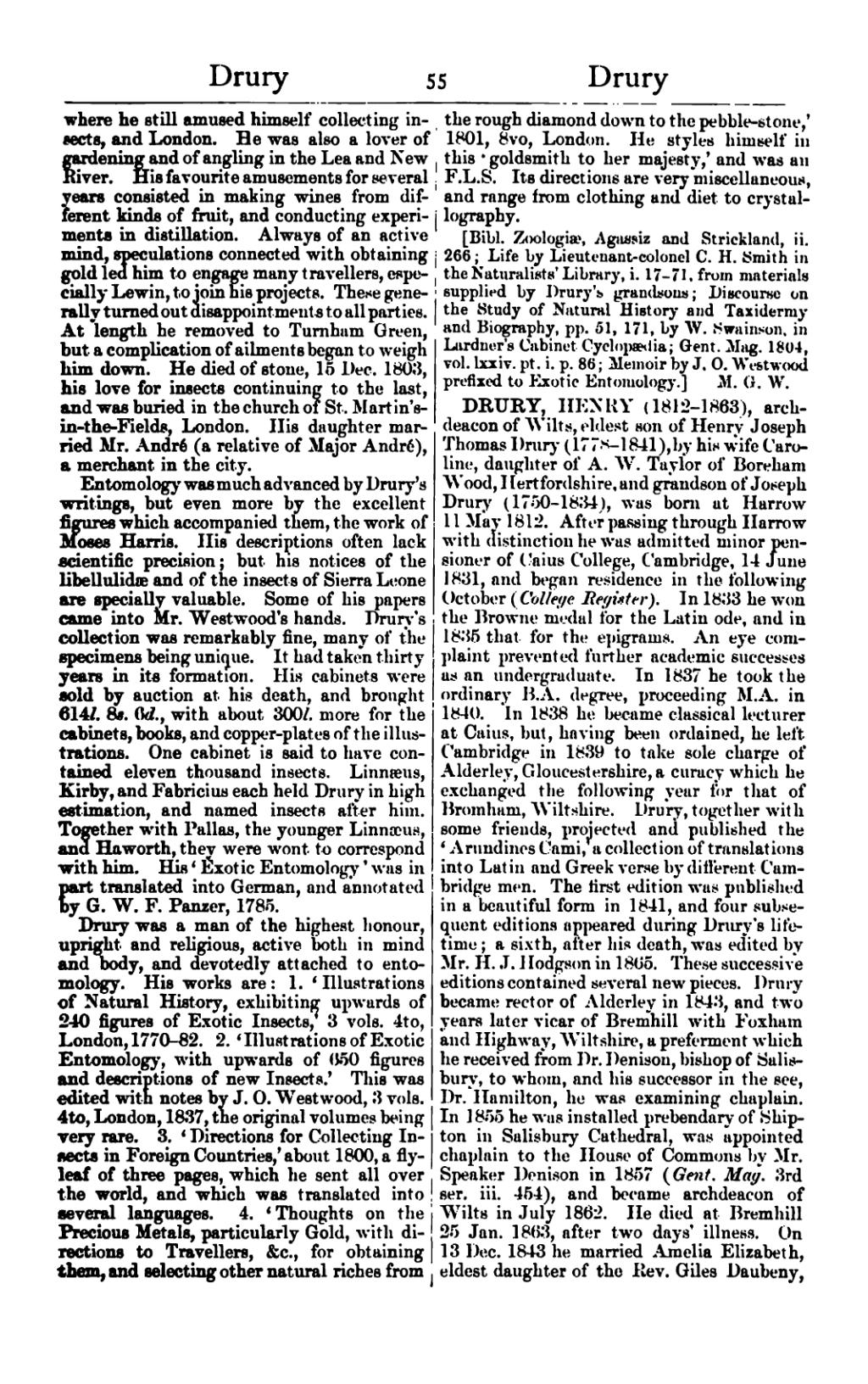where he still amused himself collecting insects, and London. He was also a lover of gardening and of angling in the Lea and New River. His favourite amusements for several years consisted in making wines from different kinds of fruit, and conducting experiments in distillation. Always of an active mind, speculations connected with obtaining gold led him to engage many travellers, especially Lewin, to join his projects. These generally turned out disappointments to all parties. At length he removed to Turnham Green, but a complication of ailments began to weigh him down. He died of stone, 15 Dec. 1803, his love for insects continuing to the last, and was buried in the church of St. Martin's-in-the-Fields, London. His daughter married Mr. André (a relative of Major André), a merchant in the city.
Entomology was much advanced by Drury's writings, but even more by the excellent figures which accompanied them, the work of Moses Harris. His descriptions often lack scientific precision; but his notices of the libellulidæ and of the insects of Sierra Leone are specially valuable. Some of his papers came into Mr. Westwood's hands. Drury's collection was remarkably fine, many of the specimens being unique. It had taken thirty years in its formation. His cabinets were sold by auction at his death, and brought 614l. 8s. 6d., with about 300l. more for the cabinets, books, and copper-plates of the illustrations. One cabinet is said to have contained eleven thousand insects. Linnæus, Kirby, and Fabricius each held Drury in high estimation, and named insects after him. Together with Pallas, the younger Linnæus, and Haworth, they were wont to correspond with him. His ‘Exotic Entomology’ was in part translated into German, and annotated by G. W. F. Panzer, 1785.
Drury was a man of the highest honour, upright and religious, active both in mind and body, and devotedly attached to entomology. His works are: 1. ‘Illustrations of Natural History, exhibiting upwards of 240 figures of Exotic Insects,’ 3 vols. 4to, London, 1770–82. 2. ‘Illustrations of Exotic Entomology, with upwards of 650 figures and descriptions of new Insects.’ This was edited with notes by J. O. Westwood, 3 vols. 4to, London, 1837, the original volumes being very rare. 3. ‘Directions for Collecting Insects in Foreign Countries,’ about 1800, a flyleaf of three pages, which he sent all over the world, and which was translated into several languages. 4. ‘Thoughts on the Precious Metals, particularly Gold, with directions to Travellers, &c., for obtaining them, and selecting other natural riches from the rough diamond down to the pebble-stone,’ 1801, 8vo, London. He styles himself in this ‘goldsmith to her majesty,’ and was an F.L.S. Its directions are very miscellaneous, and range from clothing and diet to crystallography.
[Bibl. Zoologiæ, Agassiz and Strickland, ii. 266; Life by Lieutenant-colonel C. H. Smith in the Naturalists' Library, i. 17–71, from materials supplied by Drury's grandsons; Discourse on the Study of Natural History and Taxidermy and Biography, pp. 51, 171, by W. Swainson, in Lardner's Cabinet Cyclopædia; Gent. Mag. 1804, vol. lxxiv. pt. i. p. 86; Memoir by J. O. Westwood prefixed to Exotic Entomology.]
DRURY, HENRY (1812–1863), archdeacon of Wilts, eldest son of Henry Joseph Thomas Drury (1778–1841), by his wife Caroline, daughter of A. W. Taylor of Boreham Wood, Hertfordshire, and grandson of Joseph Drury (1750–1834), was born at Harrow 11 May 1812. After passing through Harrow with distinction he was admitted minor pensioner of Caius College, Cambridge, 14 June 1831, and began residence in the following October (College Register). In 1833 he won the Browne medal for the Latin ode, and in 1835 that for the epigrams. An eye complaint prevented further academic successes as an undergraduate. In 1837 he took the ordinary B.A. degree, proceeding M.A. in 1840. In 1838 he became classical lecturer at Caius, but, having been ordained, he left Cambridge in 1839 to take sole charge of Alderley, Gloucestershire, a curacy which he exchanged the following year for that of Bromham, Wiltshire. Drury, together with some friends, projected and published the ‘Arundines Cami,’ a collection of translations into Latin and Greek verse by different Cambridge men. The first edition was published in a beautiful form in 1841, and four subsequent editions appeared during Drury's lifetime; a sixth, after his death, was edited by Mr. H. J. Hodgson in 1865. These successive editions contained several new pieces. Drury became rector of Alderley in 1843, and two years later vicar of Bremhill with Foxham and Highway, Wiltshire, a preferment which he received from Dr. Denison, bishop of Salisbury, to whom, and his successor in the see, Dr. Hamilton, he was examining chaplain. In 1855 he was installed prebendary of Shipton in Salisbury Cathedral, was appointed chaplain to the House of Commons by Mr. Speaker Denison in 1857 (Gent. Mag. 3rd ser. iii. 454), and became archdeacon of Wilts in July 1862. He died at Bremhill 25 Jan. 1863, after two days' illness. On 13 Dec. 1843 he married Amelia Elizabeth, eldest daughter of the Rev. Giles Daubeny,
